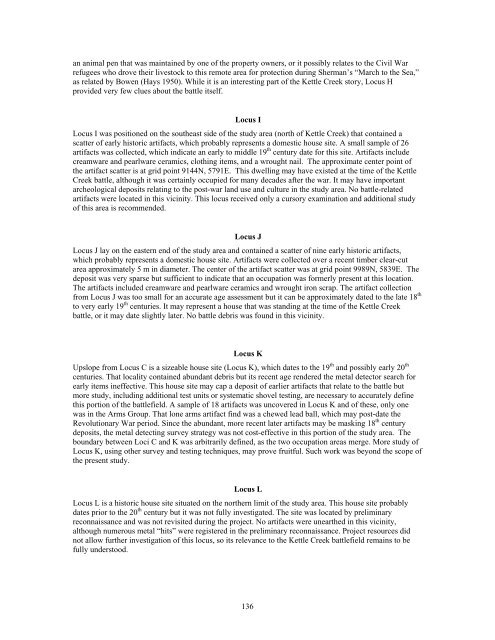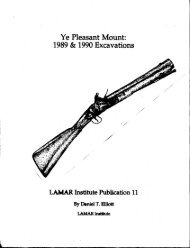Stirring Up a Hornet's Nest: - UGA Laboratory of Archaeology ...
Stirring Up a Hornet's Nest: - UGA Laboratory of Archaeology ...
Stirring Up a Hornet's Nest: - UGA Laboratory of Archaeology ...
You also want an ePaper? Increase the reach of your titles
YUMPU automatically turns print PDFs into web optimized ePapers that Google loves.
an animal pen that was maintained by one <strong>of</strong> the property owners, or it possibly relates to the Civil War<br />
refugees who drove their livestock to this remote area for protection during Sherman’s “March to the Sea,”<br />
as related by Bowen (Hays 1950). While it is an interesting part <strong>of</strong> the Kettle Creek story, Locus H<br />
provided very few clues about the battle itself.<br />
Locus I<br />
Locus I was positioned on the southeast side <strong>of</strong> the study area (north <strong>of</strong> Kettle Creek) that contained a<br />
scatter <strong>of</strong> early historic artifacts, which probably represents a domestic house site. A small sample <strong>of</strong> 26<br />
artifacts was collected, which indicate an early to middle 19 th century date for this site. Artifacts include<br />
creamware and pearlware ceramics, clothing items, and a wrought nail. The approximate center point <strong>of</strong><br />
the artifact scatter is at grid point 9144N, 5791E. This dwelling may have existed at the time <strong>of</strong> the Kettle<br />
Creek battle, although it was certainly occupied for many decades after the war. It may have important<br />
archeological deposits relating to the post-war land use and culture in the study area. No battle-related<br />
artifacts were located in this vicinity. This locus received only a cursory examination and additional study<br />
<strong>of</strong> this area is recommended.<br />
Locus J<br />
Locus J lay on the eastern end <strong>of</strong> the study area and contained a scatter <strong>of</strong> nine early historic artifacts,<br />
which probably represents a domestic house site. Artifacts were collected over a recent timber clear-cut<br />
area approximately 5 m in diameter. The center <strong>of</strong> the artifact scatter was at grid point 9989N, 5839E. The<br />
deposit was very sparse but sufficient to indicate that an occupation was formerly present at this location.<br />
The artifacts included creamware and pearlware ceramics and wrought iron scrap. The artifact collection<br />
from Locus J was too small for an accurate age assessment but it can be approximately dated to the late 18 th<br />
to very early 19 th centuries. It may represent a house that was standing at the time <strong>of</strong> the Kettle Creek<br />
battle, or it may date slightly later. No battle debris was found in this vicinity.<br />
Locus K<br />
<strong>Up</strong>slope from Locus C is a sizeable house site (Locus K), which dates to the 19 th and possibly early 20 th<br />
centuries. That locality contained abundant debris but its recent age rendered the metal detector search for<br />
early items ineffective. This house site may cap a deposit <strong>of</strong> earlier artifacts that relate to the battle but<br />
more study, including additional test units or systematic shovel testing, are necessary to accurately define<br />
this portion <strong>of</strong> the battlefield. A sample <strong>of</strong> 18 artifacts was uncovered in Locus K and <strong>of</strong> these, only one<br />
was in the Arms Group. That lone arms artifact find was a chewed lead ball, which may post-date the<br />
Revolutionary War period. Since the abundant, more recent later artifacts may be masking 18 th century<br />
deposits, the metal detecting survey strategy was not cost-effective in this portion <strong>of</strong> the study area. The<br />
boundary between Loci C and K was arbitrarily defined, as the two occupation areas merge. More study <strong>of</strong><br />
Locus K, using other survey and testing techniques, may prove fruitful. Such work was beyond the scope <strong>of</strong><br />
the present study.<br />
Locus L<br />
Locus L is a historic house site situated on the northern limit <strong>of</strong> the study area. This house site probably<br />
dates prior to the 20 th century but it was not fully investigated. The site was located by preliminary<br />
reconnaissance and was not revisited during the project. No artifacts were unearthed in this vicinity,<br />
although numerous metal “hits” were registered in the preliminary reconnaissance. Project resources did<br />
not allow further investigation <strong>of</strong> this locus, so its relevance to the Kettle Creek battlefield remains to be<br />
fully understood.<br />
136










